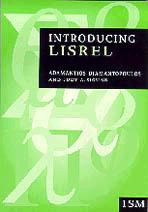
Introducing LISREL
A Guide for the Uninitiated
- Adamantios Diamantopoulos - University of Vienna, Austria
- Judy A Siguaw - Cornell University, USA
Emphasizing substantive issues rather than intricate statistical details, this book provides a comprehensive introduction to LISREL for structural equation modeling (SEM) using a non-technical, user-oriented approach that. The emphasis is on:
- exposing the reader to the major steps associated with the formulation and testing of a model under the LISREL framework
- describing the key decisions associated with each step
- highlighting potential problems and limitations associated with LISREL modeling
- assisting the interpretation of LISREL input and output files.
The overall aim is to provide a critical understanding of what is really involved in LISREL modeling and sensitize the reader against `mechanically' fitting or modifying models.
The entire range of decisions associated with the practical application of the LISREL program is covered in a user-friendly fashion. Concrete examples are used throughout to illustrate issues relating to model conceptualization, specification, identification, estimation, evaluation, modification, and cross-validation and illustrated with actual program output.
The program is made much more accessible by adopting the more user-friendly SIMPLIS command language for preparing input files. Although primarily aimed at beginning users, readers are directed to further reading together with a comprehensive bibliography for the more advanced user.
`This is a good book because it does what it says on the tin, providing the uninitiated with an introduction to LISREL of quite exceptional clarity, but does so without patronising its readersor shying away from the fact that LISREL involves some fairly demanding statistics and that its successful application requires a rigorous approach to model formulation' - International Journal of Market Research





